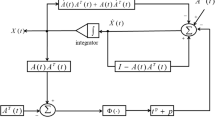Abstract
Being with parallel-computation nature and convenience of hardware implementation, linear gradient neural networks (LGNN) are widely used to solve large-scale online matrix-involved problems. In this paper, two improved GNN (IGNN) models, which are activated by nonlinear functions, are first developed and investigated for Moore-Penrose inverse of full-rank matrix. The global convergence performances of such two models and LGNN models are theoretically analyzed. Two illustrative examples are performed to further demonstrate the theoretical results as well as the feasibility and efficacy of the proposed IGNN models for solving full-rank matrix Moore-Penrose inverse in real time. At last, a robot application example is provided to show the practical utility of the proposed IGNN models.









Similar content being viewed by others
Explore related subjects
Discover the latest articles, news and stories from top researchers in related subjects.References
Chen K (2013) Implicit dynamic system for online simultaneous linear equations solving. Electron Lett 49(2):101–102
Chen Y, Yi C, Qiao D (2013) Improved neural solution for the Lyapunov matrix equation based on gradient search. Inf Process Lett 113(22–24):876–881
Chountasis S, Pappas D, Katsikis VN (2009) Image restoration via fast computing of the Moore–Penrose inverse matrix. Proc IEEE Conf Syst Signals Image Process 17(6):1–4
Duan W, Wang D, Liu C (2017) Integral sliding mode fault-tolerant control for spacecraft with uncertainties and saturation. Asian J Control 19(1):372–381
Górecki T, Łuczak M (2013) Linear discriminant analysis with a generalization of the Moore–Penrose pseudoinverse. Int J Appl Math Comput Sci 23(2):463–471
Guo D, Zhang Y (2014) Li-function activated ZNN with finite-time convergence applied to redundant manipulator kinematic control via timevarying Jacobian matrix pseudoinversion. Appl Soft Comput 24:158–168
Guo D, Xu F, Yan Y (2017) New pseudoinverse-based path-planning scheme with PID characteristic for redundant robot manipulators in the presence of noise. IEEE Trans Control Syst Tech 99:1–12
Horn RA, Johnson CR (1991) Topics in matrix analysis. Cambridge University Press, Cambridge
Huang S, Zhao G, Chen M (2018) Tensor extreme learning design via generalized Moore–Penrose inverse and triangular type-2 fuzzy sets. Neural Comput Appl. https://doi.org/10.1007/s00521-018-3385-5
Hunter J (2014) Generalized inverses of Markovian kernels in terms of properties of the Markov chain. Linear Algebra Appl 447:38–55
Ji J, Chen X (2014) A new method for computing Moore–Penrose inverse through Gauss–Jordan elimination. Appl Math Comput 245:271–278
Jin L, Li S, Liao B, Zhang Z (2017) Zeroing neural networks: a survey. Neurocomputing 267:597–604
Lee M, Kim D (2017) On the use of the Moore–Penrose generalized inverse in the portfolio optimization problem. Financ Res Lett 22:259–267
Li S, Wang Z, Li Y (2013) Using Laplacian eigenmap as heuristic information to solve nonlinear constraints defined on a graph and its application in distributed range-free localization of wireless sensor networks. Neural Process Lett 37(3):1–14
Li S, Li Y (2014) Nonlinearly activated neural network for solving time-varying complex Sylvester equation. IEEE Trans Cybern 44(8):1397–1407
Liu J, Chen S, Tan X, Zhang D (2007) Efficient pseudoinverse linear discriminant analysis and its nonlinear form for face recognition. Int J Pattern Recogn Artif Intell 21(8):1265–1278
Lv X, Xiao L, Tan Z, Yang Z (2018) Wsbp function activated Zhang dynamic with finite-time convergence applied to Lyapunov equation. Neurocomputing 314:310–315
Paszkiel S (2017) Characteristics of question of blind source separation using Moore–Penrose pseudoinversion for reconstruction of EEG signal. In: ICA 2017. Advances in Intelligent Systems and Computing, vol 550, pp 393–400
Sheng X (2018) Computation of weighted Moore–Penrose inverse through Gauss–Jordan elimination on bordered matrices. Appl Math Comput 323:64–74
Stanimiroviá PS, Petkoviá MD, Gerontitis D (2018) Gradient neural network with nonlinear activation for computing inner inverses and the Drazin inverse. Neural Process Lett 48:109–133
Stanimiroviá PS, Petkoviá MD (2018) Gradient neural dynamics for solving matrix equations and their applications. Neurocomputing 306:200–212
Sturges RH (1988) Anolog matrix inversion (robot kinematics). IEEE J Robot Automat 4(2):157–162
Wang H, Li J, Liu H (2006) Practical limitations of an algorithm for the singular value decomposition as applied to redundant manipulators. Proc IEEE Conf Robot Autom Mechatron 1:1–6
Wang J (1993) A recurrent neural network for real-time matrix inversion. Appl Math Comput 55(1):89–100
Wang J (1997) Recurrent neural networks for computing pseudoinverses of rank-deficient matrices. SIAM J Sci Comput 18(5):1479–1493
Wang X, Ma H, Stanimiroviá PS (2017) Nonlinearly activated recurrent neural network for computing the Drazin inverse. Neural Process Lett 46:195–217
Wei Y (2000) Recurrent neural networks for computing weighted Moore–Penrose inverse. Appl Math Comput 116(3):279–287
Wei Y, Cai J, Ng MK (2004) Computing Moore–Penrose inverses of Toeplitz matrices by Newton’s iteration. Math Comput Model 40:181–191
Xiao L (2016) A nonlinearly activated neural dynamics and its finite-time solution to time-varying nonlinear equation. Neurocomputing 173:1983–1988
Xiao L, Liao B (2016) A convergence-accelerated Zhang neural network and its solution application to Lyapunov equation. Neurocomputing 193:213–218
Yi C, Chen Y, Lu Z (2011) Improved gradient-based neural networks for online solution of Lyapunov matrix equation. Inform Process Lett 111(16):780–786
Zhang Y, Chen K, Tan H (2009) Performance analysis of gradient neural network exploited for online time-varying matrix inversion. IEEE Trans Autom Control 54(8):1940–1945
Zhang Y, Yang Y, Tan N, Cai B (2011) Zhang neural network solving for time-varying full-rank matrix Moore–Penrose inverse. Computing 92(2):97–121
Zhang Y, Guo D, Li Z (2013) Common nature of learning between back-propagation and Hopfield-type neural networks for generalized matrix inversion with simplified models. IEEE Trans Neural Netw Learn Syst 24(4):579–592
Zhou B, Li Z, Duan G, Wang Y (2009) Weighted least squares solutions to general coupled Sylvester matrix equations. J Comput Appl Math 224(2):759–776
Author information
Authors and Affiliations
Corresponding author
Additional information
Publisher's Note
Springer Nature remains neutral with regard to jurisdictional claims in published maps and institutional affiliations.
Rights and permissions
About this article
Cite this article
Lv, X., Xiao, L., Tan, Z. et al. Improved Gradient Neural Networks for Solving Moore–Penrose Inverse of Full-Rank Matrix. Neural Process Lett 50, 1993–2005 (2019). https://doi.org/10.1007/s11063-019-09983-x
Published:
Issue Date:
DOI: https://doi.org/10.1007/s11063-019-09983-x




